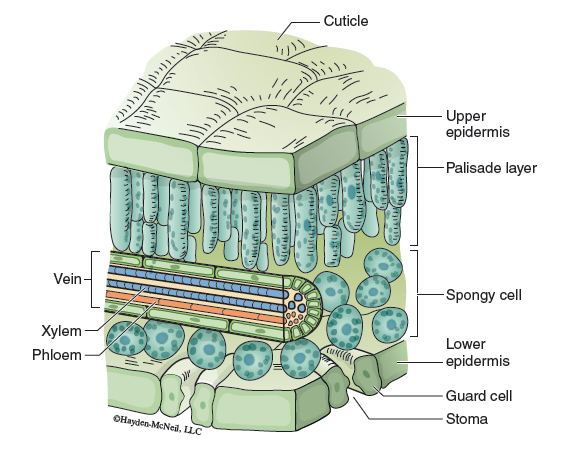Chapter 2. Carbon Metabolism: Rate of Photosynthesis
General Purpose
This pre-lab will present some of the general concepts related to the indirect measurement of the net rate of photosynthesis by measuring oxygen production as assayed by leaf disk buoyance.
Learning Objectives
General Purpose
Conceptual
- Understand the meaning of net photosynthesis.
- Understand the relationship between leaf disk buoyance or “time to float” and the rate of photosynthesis.
Procedural
- Understand the function of the sodium bicarbonate solution (NaHCO3) in this investigation.
- Understand the use of vacuum infiltration to sink the leaf disks.
Background Information
The internal anatomy of a typical leaf provides the structure that will be used to indirectly measure the net rate of photosynthesis. The mesophyll (middle leaf ) of a leaf generally has two layers, a palisade layer and a spongy layer (Figure 8-2).

The spongy mesophyll layer has many intercellular spaces. These spaces serve as a place for gas exchange between the plant cells and the atmosphere. Carbon dioxide from the atmosphere can diffuse into the spongy layer via the stoma opening in the lower epidermis. The CO2 can then diffuse into the cells and be utilized in the Calvin cycle. Conversely, oxygen produced by the light reactions accumulates in the intercellular spaces of the spongy mesophyll tissue and eventually diffuses out through the stoma to the atmosphere.
This anatomy and these reactions can be used to indirectly estimate the rate at which oxygen is evolved during photosynthesis. If the spongy mesophyll layer can be filled with liquid, then the leaf will sink. When photosynthesis-produced oxygen collects in the spongy layer, then the buoyance of the leaf will increase and it will float. The “time to float” is inversely proportional to net photosynthetic rate in the leaf tissue. This means that a long “time to float” results from a small net rate of oxygen production. Using this method, it is possible to measure the effect of several variables on photosynthetic rate in leaves of higher plants.
For this technique you will use leaf disks infiltrated with sodium bicarbonate (NaHCO3). The leaf disks are cut from leaves and placed in the bicarbonate solution and subjected to a vacuum. The bicarbonate solution will replace the gases in the intercellular spaces of the leaf and cause the leaf disks to sink to the bottom of the solution. In the presence of light and carbon dioxide (provided by the bicarbonate solution) photosynthesis will take place in the leaf disks. When enough oxygen accumulates in the intercellular spaces of the tissue, each disk will regain its buoyancy and turn on edge or float to the surface of the solution.
The net rate of photosynthesis (oxygen produced by photosynthesis minus oxygen consumed by aerobic respiration) in the disks is thus indirectly determined by noting the time required for submerged leaf disks to float.
To prepare for the second exercise of the laboratory, make a copy of Table 8-2 in your laboratory notebook.
Table 8-2. Data from floating disk investigation.
Pre-Lab Quiz
Proceed to the Pre-Lab Quiz